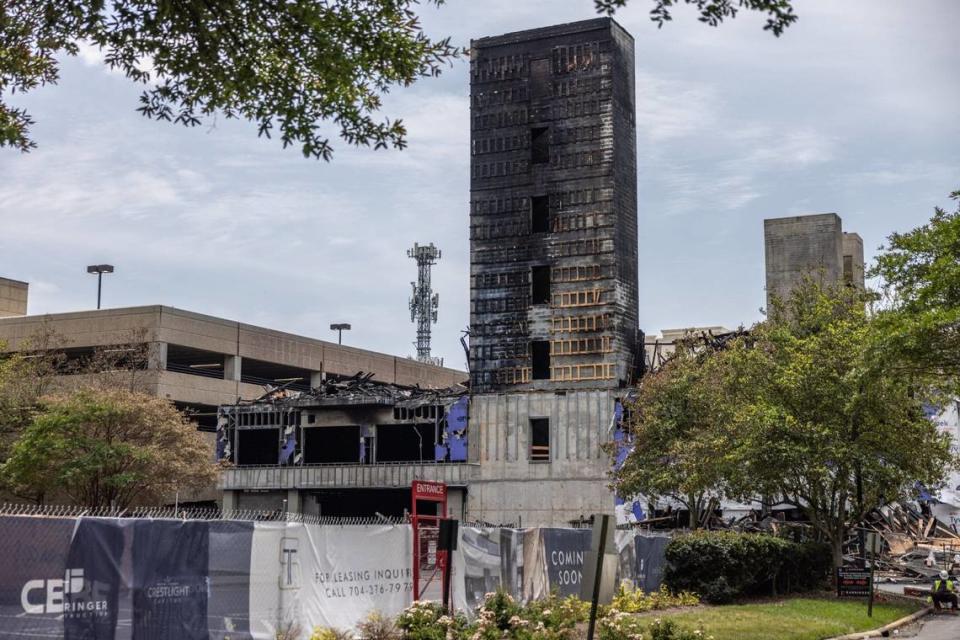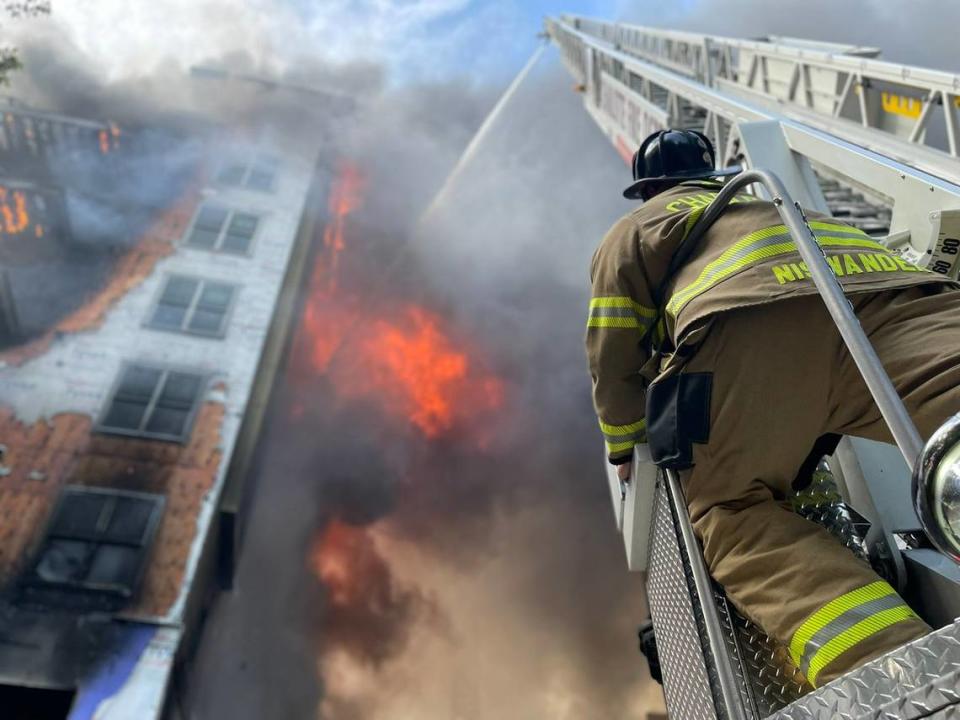Men killed in SouthPark fire couldn’t reach exit. Would another way out have saved them?
- Oops!Something went wrong.Please try again later.
One morning last month, as smoke filled the sixth floor of a large apartment building under construction near SouthPark Mall, workers Reuben Holmes and Demonte Sherrill grew desperate.
They were about a football field away from the only exit, they told their boss in a panicked phone call just after 9:20 am.
Keith Suggs, owner of a door and window installation company, instructed them to get on the floor and crawl toward the stairwell exit. But they said the smoke was too thick for them to see the exit, Suggs said.
Their remains were later discovered in the charred rubble from the massive, five-alarm blaze.
“I wish there was another set of stairs on the other end of that building,” Suggs said. “My guys would have had another chance to escape.”
Fire prevention experts contacted by The Charlotte Observer say that what happened to Holmes and Sherrill raises a vital question: Should more exits be required on large buildings under construction?
Local and state fire safety officials are now discussing that question.
“While the building is under construction, that’s arguably when it is most vulnerable,” said Jim Milke, chair of the department of fire protection engineering at the University of Maryland.

Safety concerns raised after Charlotte fire
The sixth floor of the Modera SouthPark apartment building was to be more than 32,000 square feet when complete, according to plans The Observer obtained through a public records request. At that stage of construction, though, just one exit was required by the state fire code, a news release from the Charlotte Fire Department said.
That could change as a result of the discussions now underway among state fire officials as they consider updates to the state fire code, which is based on standards that are eight and 10 years old.
Charlotte Senior Fire Inspector Colin Triming, who chairs the state’s Fire Code Revision Committee, posed the idea of requiring more exits at a June 6 meeting in Greensboro. That was 19 days after the May 18 Charlotte blaze.
“In buildings that are large, it makes sense that we have more than one temporary lit exit,” Triming later told The Charlotte Observer.

Buildings under construction pose risks because fire suppression devices like sprinkler systems typically aren’t installed until the last phase of construction, fire safety officials say.
“Definitely, you need to have multiple exits,” said Tom Brewer, a former captain for the Charlotte Fire Department who is president of the Charlotte Firefighters Association.
If adopted, the new language being considered by the state’s Fire Code Revision Committee would scale the number of exits at a construction site to the number planned for the finished building.
Experts: One exit isn’t enough
Once finished, the Modera SouthPark apartment building was to have three exit stairways on each floor, a county spokesperson said. Triming said that under his suggested change, the building would have at least two exits available on each floor during construction.
A spokesman for the Charlotte Fire Department said the building had just one exit at the time of the fire, and just one was required by the state fire code.
But three fire safety experts contacted by The Observer questioned why just one exit was available to the workers who perished.
Milosh Puchovsky, a professor at the Department of Fire Protection Engineering at Worcester Polytechnic Institute in Massachusetts, called the lack of a second exit “a head-scratcher.”
And John Heinen, a Charlotte-based regional practice leader at Telgian, a fire protection engineering consultant firm, said “the best practice is to have more than one way out of anything.”
“We have back doors on our house for a reason,” he said. “It’s not just to get to the backyard.”
A spokesperson for Mill Creek Residential, the Florida-based developer on the project, said company officials are “actively investigating the circumstances that led to the fire, and are cooperating with state and local authorities in their investigation.” The spokesperson declined to comment further.

The fire, one of the largest Charlotte firefighters have encountered in decades, reduced much of the construction site to char. Firefighters, with help from a crane operator working at the site, rescued 15 people.
Fire officials say the blaze began in a spray foam insulation trailer on the first floor of the building. In its June 6 news release, the Charlotte fire department said it had no new information on what sparked the fire, but added: “Fire Investigators determined multiple accidental heat sources were in the trailer.”
No fire inspection was done at the construction site before the blaze, the fire department said last week. That’s because the contractor failed to alert the Charlotte Fire Marshal’s office about its construction and progress, as Mecklenburg County requires.
Fire officials also said no standpipe — a vertical water pipe to which fire hoses can be connected — had been installed at the 239-unit apartment building. The state fire code requires that at least one standpipe be installed during construction. Standpipes can help firefighters begin to battle fires more quickly.
The builders were using an increasingly common style of apartment building construction — known as pedestal or podium construction — in which the bottom story is made of noncombustible material like concrete or steel and the upper floors are built with wood.
While international building codes adopted by North Carolina allow for wood-frame buildings, some fire science experts worry about their vulnerability to fire.
Other changes on the table?
Triming’s committee is also discussing whether it should limit the size of some buildings, and whether it should adopt the 2022 edition of National Fire Protection Association standards that outline safety rules at construction sites.
The NFPA standards now on North Carolina’s books are from 2013, state Department of Insurance Chief Fire Code Consultant Charlie Johnson confirmed in a June 9 email.
The newer standards, among other things, include additions on a fire-prevention program manager’s role at such construction sites, said Kevin Carr, a senior fire protection specialist with NFPA.
They also have new requirements for fire-safety plans adapted to each construction project. Plans are approved by a local building or fire official — or whoever has jurisdiction where a project is built.
And there are new chapters that outline best practices for tall mass timber structures and large wood frame structures, Carr said.
North Carolina is by no means the only state using older fire safety standards, Susan McKelvey, a spokesperson for the NFPA, said in an email.
“This presents safety concerns because the most recent edition of a code or standard reflects the latest trends, issues, and learnings that older editions may not,” she wrote.
It would be a long road to implementing changes, though. Triming and other fire safety officials said the earliest that will likely happen is January 2025.
In 2014 the North Carolina Building Code Council switched from updating codes every three years to every six years. That council will also have to weigh in.
Observer data reporter Gavin Off and growth and development reporter Gordon Rago contributed to this report.
This article was modified on June 14 to clarify changes in newer editions of National Fire Protection Association standards.

